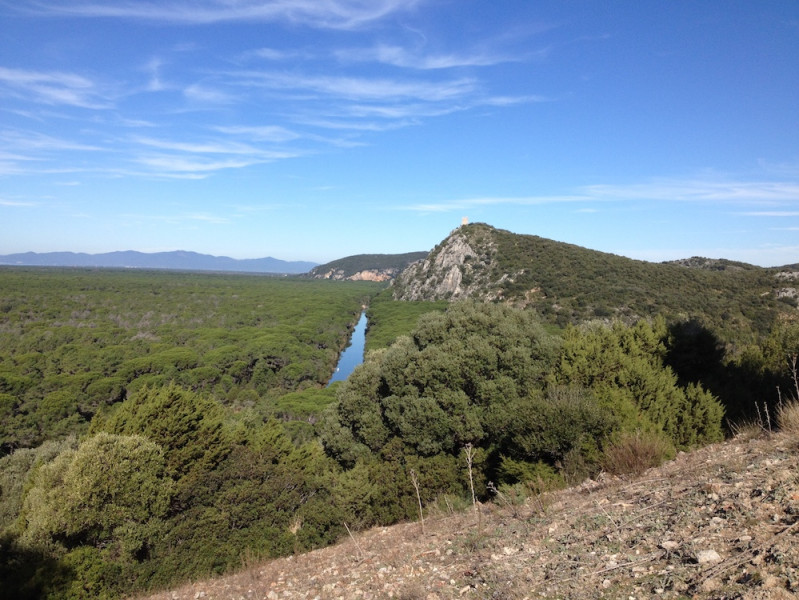


The entrance to the park is in Alberese, whose name can be derived from the antique monastery of Santa Maria in Monte Alborense. The ruins of the grand structure can be found within the territory of the park. This history of the area – a land that was very difficult to use in the past due its marsh-like nature (much like the rest of the Maremma) is exemplary: after years of abandonment, the area experienced a revival after the work done by the Lorena family, more specifically, the hydro-geological, economic, and social improvements undertaken throughout the entire Maremma region. In particular, thanks to Leopoldo II, a huge improvement project was undertaken on the plains and continued by Leopoldo’s son Ferdinando after the unification of Italy and further continued un-interruptedly, into the 1950’s. A canalization zone was created for water drainage (the essiccatore or “drier” canal at the mouth of the Ombrone river is particularly noteworthy), a 600 hectare pine forest was planted and the first agricultural machines were introduced.
Leopoldo II later bought the Alberese business helping it to become model of productivity and efficiency. Later, in 1902, the first mezzadria, or land divisions - to help partition the land - for various uses were introduced. After the World War, the company was taken over by the Italian government, and in 1926 was entrusted to the Ente Opera Nazionale Combattenti, which took over the improvement work of the territory. In fact, although the work had been undertaken for quite some time by then, the territory was still vastly composed of permanent swamp-like areas with intermittent areas of marsh, forest and pasture land. Thanks to the help of tens of hundreds families from the Veneto region who migrated to the area, creating a sort ethnic island, a large integrated improvement program was undertaken. A radical transformation of the zone was the result of this work, today characterized by land that is productive and well taken care of. From 1978 the Alberese farm has run by the Region of Tuscany.
The last part of the marsh area is visible in the north part of the park, starting from the area in Principina a Mare, that for years has rendered the Maremma region, unfortunately, infamous. In this area today, no longer dangerous, one of the most fascinating spectacles found in nature can be found: an ecosystem rich with organic reproduction, where many species of animals can be found in their habitat (also serving as a resting place for flocks of birds). Here flora and fauna thrive together in perfect equilibrium: amongst the pools of still water reeds and rock roses, that often represent the favoured refuge for insects and animals, can be admired. Rare birds, like the Cavaliere d’Italia, the Germano Reale and many others, find the nutrition needed for their survival in this area. Migratory birds of every type frequently find a resting spot during their long travels here in the park. Many canals can be found throughout the park, including the essiccatore canal, that once having collected the water from the Alberese water storage basin brings the water right to the mouth of the Ombrone river. On the edges of the canals a wide variety of vegetation can be admired and sometimes even turtles and marine snakes can be seen. The Ombrone river, among one of the cleanest rivers in all of Tuscany, is also the home to a wealth of animal life, making it a fisherman’s paradise. Fishing is heavily regulated, however, and only a limited number of fishermen (60 for every 6 km of river) can fish at a time. Between the Ombrone river and Collelungo, the abundant pine forest of Alberese is found, planted in 1844 in an area that was formerly a swamp. Just behind rest the Uccellina Mountains, formerly an island, which today testifies to the abundant quantity of calcified rocks in the area. Grottos and interconnected tunnels are common in the Uccellina Mountains: one of the most notable being the Grotta della Fabbrica (where artefacts dating from the Paleolithic age have been found). The mountains represent a rare example of an entirely uncontaminated geographical area: the hills are densely covered by Mediterranean scrub, through which lentisk and wild strawberry plants can also be found poking out through the bushes. In the few more open areas, formed as a result of fire or cutting, low growing and highly aromatic bushes can be found, such as heather and rosemary. Their perfume can be smelt throughout the whole area. It is not rare to find ranging sounders of wild boar or small herds of deer even during the day. Groups of mini-palm trees, characteristic of the area, can be seen among the rocks. The Uccellina Mountains constitute the very essence of the Maremma region. They unite, in a still very intact and wild ambient, all of the harshness of the land in which the animals, vegetation and human inhabitants of the area cannot be anything less than extremely resistant to survive. The park represents a point of reference not only for the nature lover, but also for those who simply enjoy history: on the peaks and along the crests of the mountains one can enjoy the view of watch towers dating to the period of Siena’s domination and successive incorporation of the territory in the fortified system of the Stato dei Presidi. The seven extant examples of towers are: the Trappola, Castelmarino, Collelungo, Uccellina, Cala di Forno, Bella Marsilia, and Cannelle towers. Most of them can be connected to various local legends with protagonists like beautiful princesses and cruel Arabs.
08
Aug



PIANO DI SVILUPPO E COESIONE – PSC TOSCANA
INTERVENTI DI CUI ALLE RISORSE FSC DELIBERA CIPESS 26/2021
Supporto alla valorizzazione dell’immagine della Toscana – Maremma Toscana Area Sud
Progetto Maremma Toscana Area Sud